Yes, you can play your first piano song on your first day of playing by using just four chords!
When I was a kid, I wanted piano lessons SO BAD. I begged for them, and I still remember the day our piano arrived at our house! I was so excited!
But I was disappointed when the songs I learned at my piano lessons were tunes like “Mary Had a Little Lamb.” I wanted to play other songs. The songs I love.
Now, my piano lessons taught me many useful skills. They were just…not that inspiring.
But I’m the piano teacher now, and I know that beginners can play their favorite songs within Day 1! If you have the right tools. This is what I want to show you in this lesson.
Subscribe to The Note for exclusive interviews, fascinating articles, and inspiring lessons delivered straight to your inbox. Unsubscribe at any time.
Here’s a fun fact: most songs are based on something called a chord progression.
A chord progression is a series of chords that repeats itself. In popular music, this series is often just four chords.
And while there are many ways to make them fancy, in their most basic form, these chords are very easy to play and very easy to find.

Change chords better and master two songs in just 10 minutes a day for 30 days with expert support from real teachers. Next cohort starts Jun 5, 2023.
SAVE YOUR SEATTo find our four magic chords, we first have to learn a scale. We’ll use the C scale, which is a row of notes from C to C on the keyboard.
First, find C. It’s the white key on the very left of the group of two black keys.
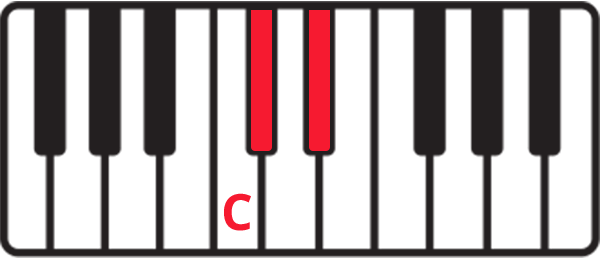
These are the names of the notes in the C scale. It’s just the alphabet!

Next, we’ll assign each key a number. C is the first note, so it’s #1. D is #2, E is #3, and so on. When we get back to C, we’re back to #1. So there should only be numbers 1 to 7.

Now let’s start building chords!
Go to note #1: C. Put your thumb on C. If you let your hands naturally fall on the keys, one to one, then you’ll see that your pinky lands on G.
Play C and G together. This is a C shell chord.
A full C chord would be C-E-G (using your middle finger to play the E). You can play this if you like, but it can be a challenging movement for beginners, whose fingers can get squished together. So, a shell chord works just fine for now.
So, play C-G. We also call this the I chord because it is built on the first note of the scale (C). We’ll use Roman numerals to number chords (more on this later).
Subscribe to The Note for exclusive interviews, fascinating articles, and inspiring lessons delivered straight to your inbox. Unsubscribe at any time.
Using this same concept, we’ll find the rest of our chords.
Now, our magic four chords are the I, the V, the vi, and the IV.
This means we’ll build shell chords on the first, the fifth, the sixth, and the fourth notes of the C scale. Don’t remember what these are? Refer back to the graphic where we numbered each note of the scale 🙂
The first note of the scale is C. Make this a shell chord by playing C-G. This is our I chord.
To play the next chord, just scooch the same hand-shape over to G…
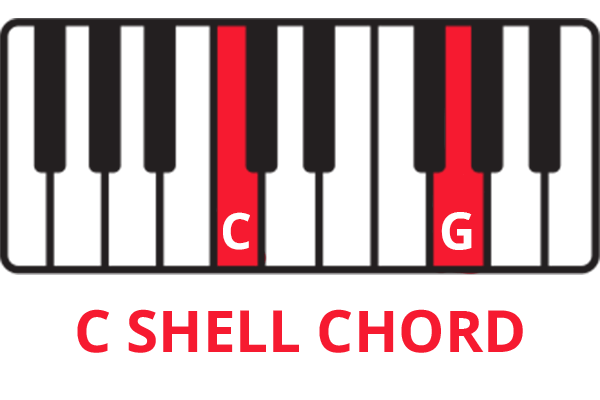
The fifth note of the scale is G. Make this a shell chord by playing G-D. This is our V chord.
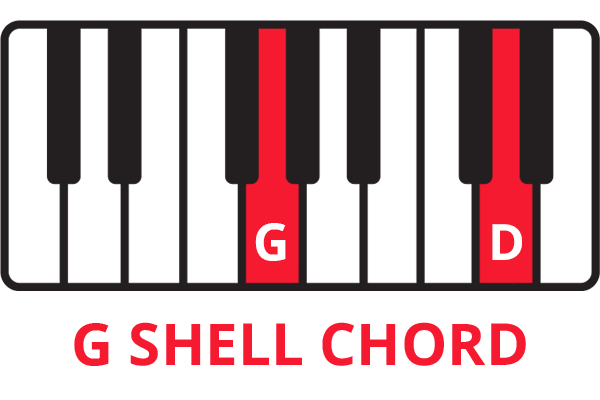
Our sixth note of the scale is A. Make this a shell chord by playing A-E. This is our vi chord.
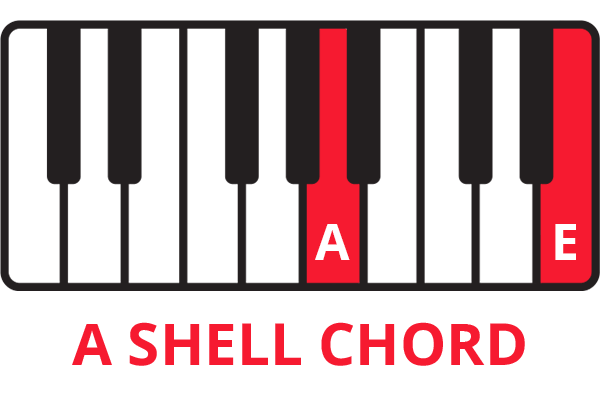
Finally, the fourth note of the scale is F. Shell chord: F-C. This is our IV chord.
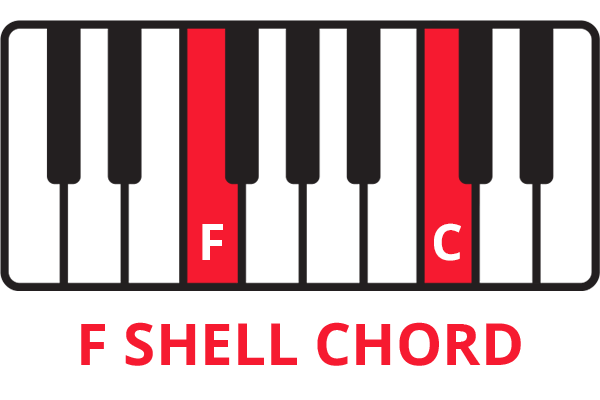
Our left hand has been sitting idle for a while, so let’s invite it to the party!
We’ll use it to play the same note that each chord is built on, just lower. Remember that we can find all the Cs on the keyboard by looking at the bottom-left white key of a group of two black keys.
So your bass notes are:
C – G – A – F
Try playing them together with your right hand shell chords.
Now play the chords one after the other…and guess what? You’ve basically played every pop song ever written.
Need proof? Watch the video and see me use these chords to play “Don’t Stop Believin’” (Journey), “Love Story” (Taylor Swift), and “Let It Go” (from Frozen).
🎹 Learn more about chord progressions: No two songs are the same, but many songs use the same handful of chord progressions! Each has its own character and mood. Learn more about chord progressions here.There are two ways to name the chord progression we just played. One is by using numbers:
I – V – vi – IV
The other is by using chord names:
C – G – Am – F
Chord names are what you most often see on chord charts, where there are lyrics on the bottom and chord names on top. This means the chords change when a chord name matches up with a lyric.
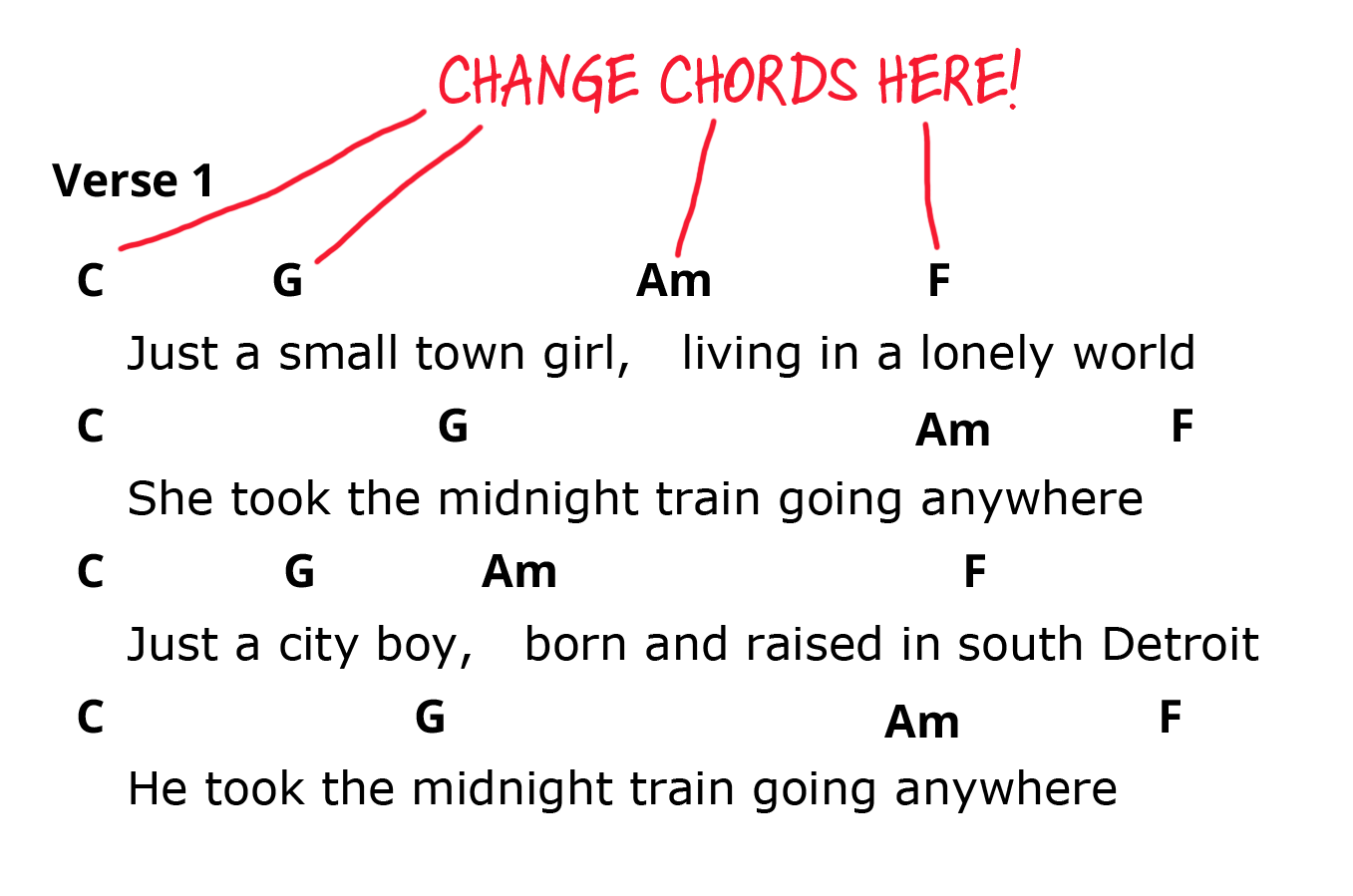
You can see a demonstration of this in action when I play “Don’t Stop Believin’” with the chord chart at the bottom of the screen.
If you’re wondering why there’s a little “m” next to the A. That’s because this is a minor chord. It has a “sad” sound. If you play the full chord (A-C-E), it’ll sound “sad.” This is also why we use lowercase Roman numerals (“vi”) to represent this chord numerically.
There’s a bunch of theory that explains this. Don’t worry about it right now, but if you’re curious, here’s a more thorough explanation.
You’ll be delighted to know that you now have the four magic tools to start playing hundreds of songs.
Here are some songs that use these chords. Not always in the same order, but the same shapes:
Click on those links to get free chord charts for all these songs…and start playing your first piano song!
Lisa Witt has been teaching piano for more than 20 years and in that time has helped hundreds of students learn to play the songs they love. Lisa received classical piano training through the Royal Conservatory of Music, but she has since embraced popular music and playing by ear in order to accompany herself and others. Learn more about Lisa.
/marketing/pianote/promos/april/banner-bg-m.webp)
We use cookies for traffic data and advertising. Cookie Policy »
/marketing/pianote/promos/april/banner-title.webp)